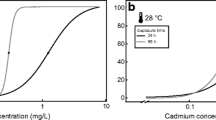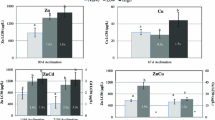Abstract
Fingerling size Salmo gairdneri, Oncorhynchus kisutch, Notemigonus crysoleucas, Cyprinus carpio, and Ictalurus punctatus were exposed in the laboratory three times daily for up to seven days to pulses of either free chlorine or monochloramine. This regime simulated conditions often encountered in the outfall of steam electric generating plants which chlorinate intermittently. LC50's, LT50's and response isopleths giving various percentage mortalities, were computed from the bioassays. S. gairdneri, O. kisutch, and I. punctatus were the most sensitive to both types of chlorine. C. carpio were most resistant and the N. crysoleucas were intermediate in sensitivity. Temperature had relatively little effect on the toxicity of intermittent chlorine to the species tested. In this type of test regime, free chlorine was three to fourteen-fold more toxic (depending on the species) than monochloramine. Water quality criteria for the protection of fish should, in the future, take this differential toxicity into consideration.
Similar content being viewed by others
References
Basch, R. E. & Truchan, J. G. 1976. Toxicity of chlorinated power plant condensor cooling waters to fish. U. S. Environmental Protection Agency Ecological Res. Ser. EPA-600/3-76-009 115 p.
Bass, M. L. & Heath, A. G. 1976. Toxicity of intermittent chlorination to bluegills: interaction with temperature. Bull. Env. Contam. and Tox. 17: 416–423.
Brooks, A. S. & Seegert, G. L. 1975. The toxicity of chlorine to freshwater organisms under varying environmental conditions. In R. L. Jolley (ed). Proc. of Conf. on Environm. Impact of Water Chlorination. Oak Ridge Nat. Lab. CONF-751096 pp. 277–298.
Brooks, A. S. & Seegert, G. L. 1977. The effects of intermittent chlorination on selected great lakes fishes; effects of 5- and 30-minute exposures on rainbow trout and yellow perch. Trans. Amer. Fish. Soc. 106: 278–286.
Brungs, W. A. 1973. Effects of residual chlorine on aquatic life. J. Wat. Poll. Contr. Fed. 45: 2180–2193.
Brungs, W. A. 1976. Effects of wastewater and cooling water chlorination on aquatic life. U. S. Environmental Protection Agency Ecological Res. Ser. EPA-600/3-76-098. 45 p.
Chaney, A. L. & Marbach, E. 1962. Modified reagents for determination of urea and ammonia. Clin. Chem. 8: 130–132.
Dickson, K. L., Hendricks, A. C., Crossman, J. S. & Cairns, J. C. 1974. Effects of intermittently chlorinated cooling tower blowdown on fish and invertebrates. Environ. Sci. and Technol. 8: 845–849.
Dickson, K. L., Cairns, J. C., Gregg, B. C., Messenger, D. I., Plafkin, J. L. & Van der Schalie, W. 1977. Effects of intermittent chlorination on aquatic organisms and communities. January J. Wat. Poll. Contr. Fed. p. 35–44.
Draley, J. E. 1973. Chlorination experiments at the John E. Amos plant of the Appalachian Power Co. April 9–10, 1973. Argonne Nat. Lab. Rept. No. ANL/ES-23. Environmental and Earth Sciences, Argonne, Illinois.
Finney, D. J. 1971. Probit Analysis. 3rd Ed. Cambridge Univ. Press, New York. 333 p.
Holland, G. A., Lasater, J. E., Newman, E. D. & Eldrige, W. E. 1960. Toxic effects of organic and inorganic pollutants on young salmon and trout, p. 198–214. Res. Bull. No. 5, Dept. of Fisheries, State of Washington.
Merkens, J. C. 1958. Studies on the toxicity of chlorine and chloramines to the rainbow trout. Water Waste Treatment J. 7: 150–151.
Rosenberger, D. R. 1971. The calculation of acute toxicity of free chlorine and chloramines to coho salmon by multiple regression analysis. Thesis, Michigan State Univ., East Lansing, Mich. 33 p.
Stober, Q. J. & Hanson, C. H. 1974. Toxicity of chlorine and heat to pink (Oncorhynchus gorbuscha) and chinook (O. tshawytcha) salmon. Trans. Amer. Fish. Soc. 103: 569–576.
Thatcher, T. O., Schneider, M. J. & Wolf, E. Q. (in press). Bioassays on the combined effects of chlorine, heavy metals, and tempearture on fishes and fish food organisms. Part I. Effects of chlorine and temperature on juvenile brook trout (Salvelinus fontinalis). Bull. Env. Cont. and Tox.
Tompkins, J. A. & Tsai, Chu-Fa. 1976. Survival time and lethal exposure time for the blacknose dace exposed to free chlorine and chloramines. Trans. Amer. Fish. Soc. 105: 313–321.
White, G. C. 1972. Handbook of Chlorination. Van Nostrand Reinhold, New York.
White, G. C. 1975. Current chlorination and dechlorination practices in the treatment of potable water, wastewater, and cooling water. In R. L. Jolley (ed). Proc. of Conf. on Environm. Impact of Water Chlorination. Oak Ridge Nat. Lab. CONF-751096, pp.7–24.
Author information
Authors and Affiliations
Rights and permissions
About this article
Cite this article
Heath, A.G. Toxicity of intermittent chlorination to freshwater fish: Influence of temperature and chlorine form. Hydrobiologia 56, 39–47 (1977). https://doi.org/10.1007/BF00023284
Received:
Published:
Issue Date:
DOI: https://doi.org/10.1007/BF00023284




